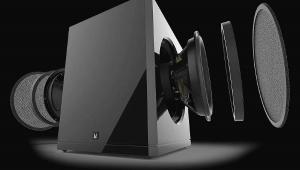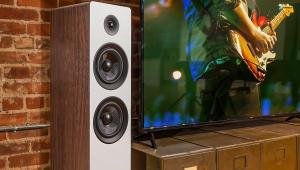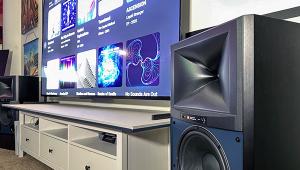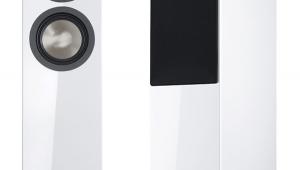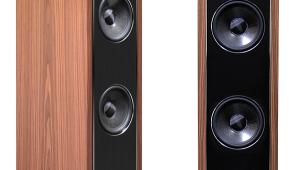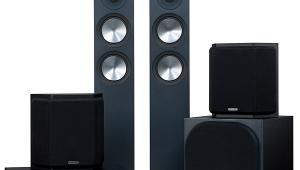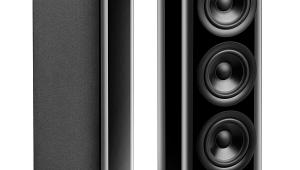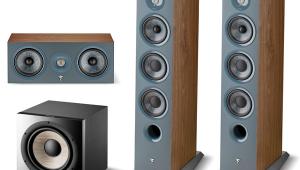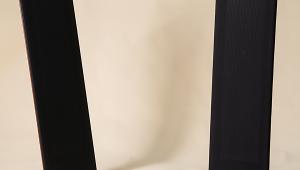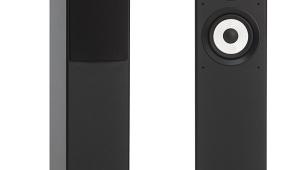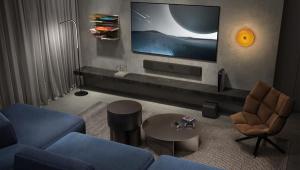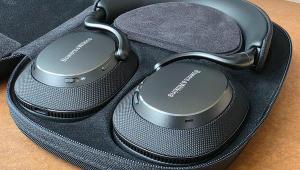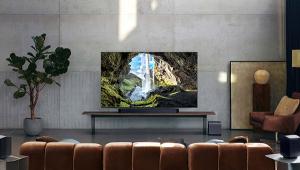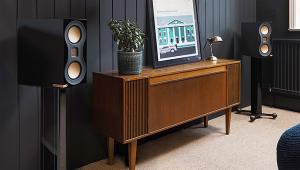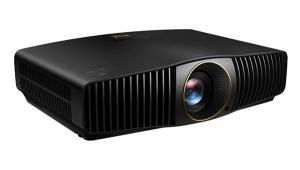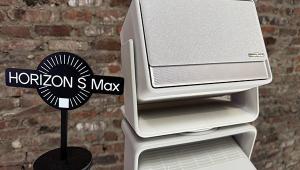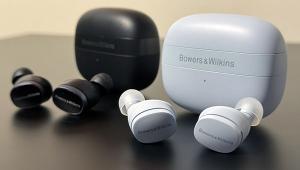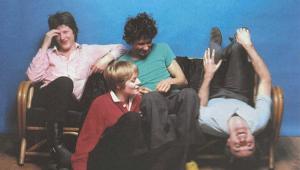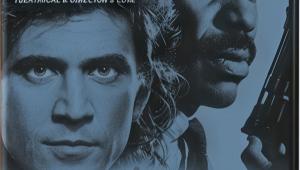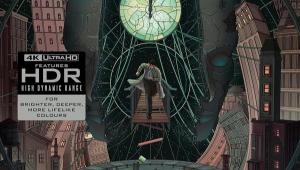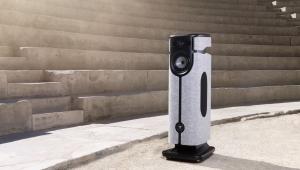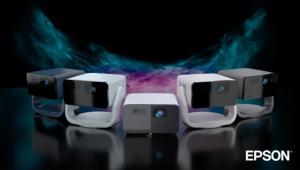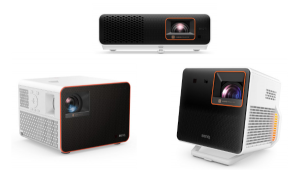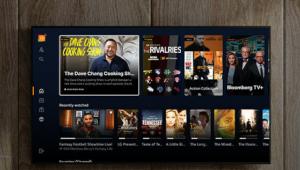Definitive Technology Mythos ST-L Loudspeaker Page 2
The midrange drivers are slightly different, though. Look closely at the outer surround of the upper midrange (it’s easier if you take off the grille, obviously), and you’ll see that the forward-bending curvature of that driver’s outer surround is the reverse of the surround’s inward curvature in the lower driver. Hidden behind the cones, the folds in the spider material that support the voice coils are also in opposite orientations. The asymmetrical design is an attempt to cancel distortion produced by nonlinear movement of one driver’s surround or spider with equal but opposite characteristics in the other driver.
Hörvergnügen?
Def Tech rejiggered its traditional all-aluminum dome tweeter design for the new Mythos ST-L, too. Among the many changes—such as a larger magnet structure, rubber (instead of silk) surround material, and new faceplate geometry—the most visible is the magnesium-aluminum alloy in the tweeter’s 1-inch dome. The alloy is said to help suppress resonance modes and ultimately flattens the response of the tweeter in the 12-to-14-kilohertz range, but a close look at the graph of the new tweeter’s frequency output reveals a significant rolloff above 18 kHz. What the funk? Does Klippel mean “no high-frequency hearing” in German? I didn’t get an answer on that, but Peet did explain that Def Tech “traded off ultra-high-frequency output” in return for “vastly lower distortion and smoother response at more relevant and audible frequencies.”

From the outside, the ST-L’s woofer configuration looks a lot like the ST’s. There’s an active, 6 x 10-inch, “racetrack-shaped” cone driver mounted on the front that’s pressure-coupled to a pair of front-firing, planar passive radiators. But Mythos ST-L’s claimed 1,200-watt Class D internal subwoofer amp is quadruple the rated power of the ST’s built-in amp. Exclusive to the ST-L is an L/R switch on the back of each tower. By itself, the left/right designation doesn’t affect the output; you and the ST-L’s remote control do. The remote lets you adjust the bass output of each tower independently or simultaneously from the listening position. Since the remote uses IR, however, it can be tricky to make simultaneous level changes if you’re not far enough away from both speakers. Each ST-L has a row of white LEDs across a panel at the bottom of the tower that provides a momentary visual confirmation of that particular speaker’s setting.
On the technical side, it’s obvious that Def Tech’s re-imagined flagship speaker has a huge amount of test-Klipp-ular fortitude. But, to borrow from an old VW ad campaign, do the Mythos ST-Ls have hörvergnügen? (“Listening pleasure”—if Babylon’s online German translation is correct.) More to the point, do they have $5,000/pair worth of hörvergnügen?
Disappearing Act
A funny thing happened on the way to this paragraph: Most of the demo tracks below are re-imaginings of classic songs. Take B.J. Thomas’ 2013 release, The Living Room Sessions, a collection of mostly “unplugged” duet redos of hits from his nearly 50-year-long career. “Most of All,” from 1970, starts with a simple guitar and percussion arrangement before Thomas’ vocals come in. It’s not long before Keb’ Mo’ fills in his part in the duet. It’s a simple, beautiful rendition that relies on the depth of emotion in the two voices for much of its power. Thomas’ mellow voice carries an almost seductive blend of confidence, satisfaction, and contentment. Keb’ Mo’s vocals, on the other hand, have a bluesy edge of a weary search for happiness that’s perfect for the sentiment of the song. “Raindrops Keep Fallin’ on My Head” (1969) presents an even more dramatic pairing of Lyle Lovett with Thomas. Lovett’s voice—sounding burdened and nearly spent—came achingly through the towers. Both songs were acid tests for the new midrange drivers in the ST-Ls, and the towers did more than just pass the test. They made me forget I was even testing them. Essentially, the ST-Ls presented the three distinctly different voices (and accompanying instrumentation) in a way that was naked and uncolored.
The Mythos ST-Ls weren’t sexist, either, reproducing female voices just as nakedly. (The ST-Ls would definitely get an R rating from the MPAA—but you’d still let your kids listen to them.) Neither Jen Chapin’s remake of “Higher Ground” (reVisions: Songs of Stevie Wonder) nor Rita Coolidge’s “People Get Ready” (Play Something Sweet) are tracks I would normally listen to because of their crawling pace, but the ST-Ls’ breathtaking reproduction of subtle changes in tone and emphasis in each woman’s voice made me want to play both tracks again and again. The Def Tech midrange sounded so amazingly “simple” and clear that it was hard to find anything to complain about.
Hearing the natural energy and snap inherent in each pluck of a guitar string or hit on a cymbal proved (to me, at least) that Def Tech made the correct choice in optimizing aspects of the new magnesium-alloy dome tweeter other than high-frequency extension. The soundstage seemed to appear slightly behind the speakers rather than aggressively forward. But to say that the soundstage was created behind the ST-Ls isn’t quite right. The soundstage and the room were actually one and the same. The Mythos ST-Ls were so effortlessly amazing that they appeared to disappear—even though I was looking right at them.
By the way, the ST-Ls were just as capable of rocking out, too. The Kenny Wayne Shepherd Band’s version of “House Is Rockin’” (Goin’ Home) was stunning in just about every respect. The ST-Ls didn’t hold anything back, especially the bass, which was tight and loud. So much so, as a matter of fact, that it was almost impossible not to believe that a full drum set and piano were in the room. On “Boogie Man,” the bass was sustained and deep and, well, so controlled that it was eerie.
Conclusion
Although it’s technically the top-of-the-line of the Mythos series of speakers, Definitive Technology’s Mythos ST-L is more—much more—than just a flagship model. One of the aspects I’ve always loved about the Mythos speakers in general is their ability to perform—in other words, to be neutral and, at the same time, exciting to listen to. True to its heritage, the ST-L is a stunning performer, so much so that it transcends the Mythos of old and truly ushers in a new era for Definitive Technology. The Mythos ST-L isn’t just another pretty powered tower—it’s a magical, emotive speaker, one that’s able to bypass the rational, thinking part of your brain and unleash deep and powerfully moving emotions trapped within. While I’m not one to casually throw money around, I have to say that, even though they’re made of aluminum, for $5,000/pair, the Mythos ST-Ls are an absolute steel…er, steal.
